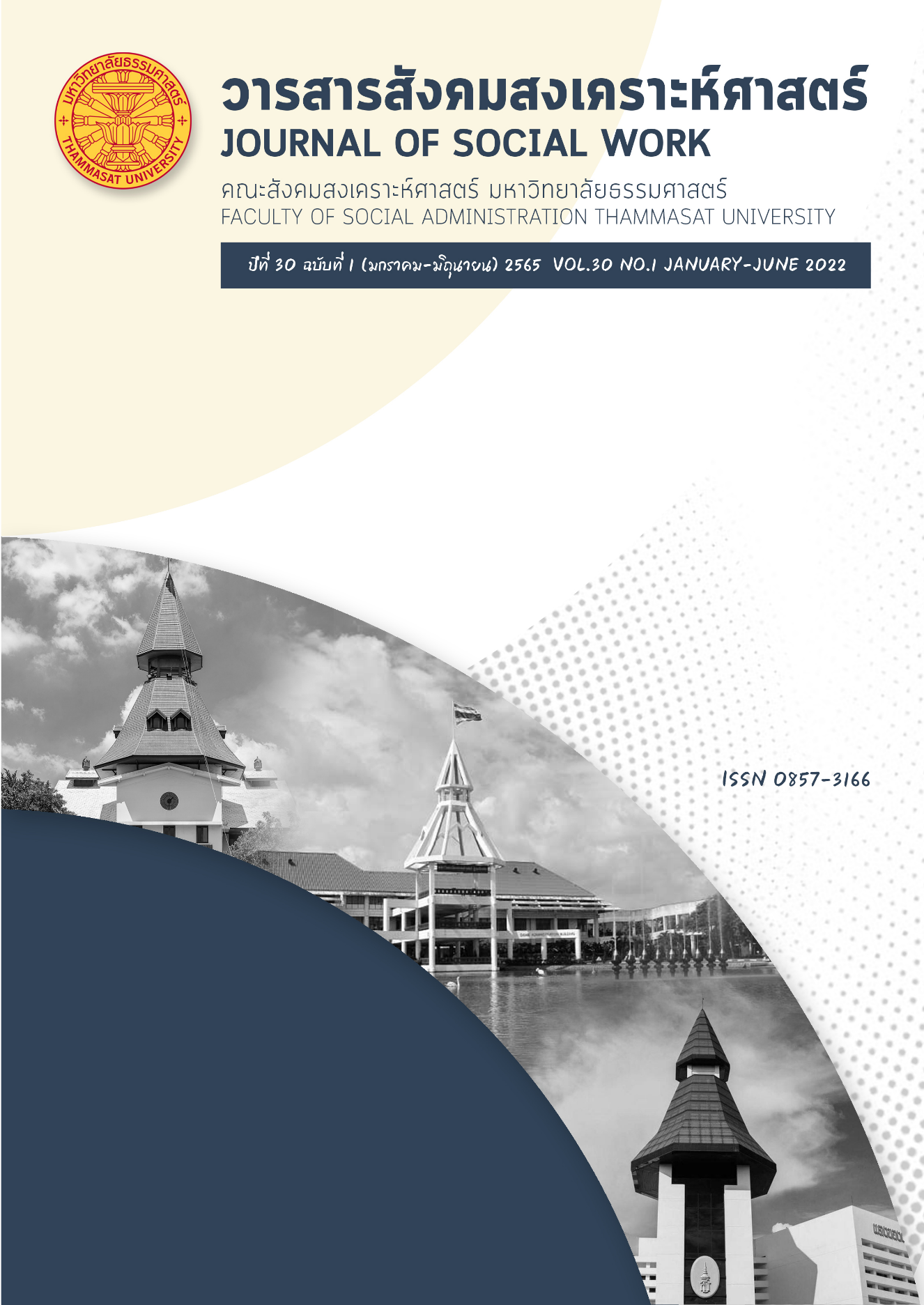เด็กและความรุนแรงในครอบครัว
คำสำคัญ:
ความรุนแรง, ความรุนแรงในครอบครัว, เด็กเป็นผู้ถูกกระทำบทคัดย่อ
การศึกษานี้มีวัตถุประสงค์เพื่อศึกษาสภาพปัญหาความรุนแรงในครอบครัวที่กระทำต่อเด็ก โดยดำเนินการวิจัยด้วยวิธีการวิจัยเชิงปฏิบัติการแบบมีส่วนร่วม มีการใช้แบบสำรวจการสังเกตแบบมีส่วนร่วม การสัมภาษณ์เชิงลึก ผู้มีส่วนร่วมในการวิจัย ได้แก่ ผู้ปกครอง จำนวน 15 ครัวเรือน และเด็กอายุ 10-12 ปี จำนวน 14 คน ที่อาศัยในพื้นที่ชุมชนจันทร์วิโรจน์ อำเภอหาดใหญ่ จังหวัดสงขลา เป็นเวลาไม่น้อยกว่า 5 ปี สามารถสื่อสารภาษาไทยได้ และผู้ปกครองยินยอมให้เข้าร่วม
ผลการศึกษาพบว่า ความรุนแรงในครอบครัวที่กระทำต่อเด็กในพื้นที่ชุมชนจันทร์วิโรจน์ ประกอบด้วย 1) การกระทำความรุนแรงด้านร่างกาย
2) การกระทำความรุนแรงด้านจิตใจ และ 3) การละเลย/ทอดทิ้ง ทำให้เกิดผลกระทบด้านสุขภาพกายและสุขภาพจิต เด็กไม่ได้รับการดูแลเมื่อเจ็บป่วย ใช้สารเสพติด เล่นการพนัน ติดเกม ไม่ได้เรียนหนังสือ ไม่สามารถควบคุมพฤติกรรม/อารมณ์ของตัวเองได้ ทำร้ายผู้อื่น ไม่ทำบัตรประจำตัวประชาชน เป็นต้น ข้อเสนอแนะที่สำคัญจากการศึกษา คือ แนวทางการป้องกัน
ความรุนแรงในครอบครัวที่กระทำต่อเด็กนั้น ควรใช้กระบวนการมีส่วนร่วมของครอบครัว โรงเรียน และชุมชน ทำงานร่วมมือกันในการดูแล แก้ไขปัญหา และปกป้องคุ้มครองเด็กในชุมชน เพราะปัญหาความรุนแรงในครอบครัวไม่ใช่เป็นหน้าที่ของครอบครัวใดครอบครัวหนึ่ง แต่เป็นหน้าที่ของทุกคน
เอกสารอ้างอิง
กระทรวงสาธารณสุข. (2547). โครงการจัดตั้งศูนย์บริการช่วยเหลือเด็กและสตรีในภาวะวิกฤติจากความรุนแรงเฉลิมพระเกียรติสมเด็จพระนางเจ้าสิริกิติ์ พระบรมราชินีนาถ (ศูนย์พึ่งได้). กรุงเทพฯ: กระทรวงสาธารณสุข.
กฤตยา อาชวนิจกุล และคณะ. (2546). ความรุนแรงในชีวิตคู่กับสุขภาพผู้หญิง. กรุงเทพฯ: สถาบันวิจัยประชากรและสังคม.
กรมกิจการเด็กและเยาวชน กระทรวงการพัฒนาสังคมและความมั่นคงของมนุษย์. (2563). รายงานสถานการณ์ด้านเด็กและเยาวชน ประจำปี 2563 สำนักงานกิจการสตรีและและสถาบันครอบครัว.
จินตนา วัชรสินธุ์ และคณะ. (2561). ได้ศึกษาปัจจัยที่มีความสัมพันธ์กับความรุนแรงในครอบครัวของเด็กวัยเรียน. วารสารเครือข่ายวิทยาลัยพยาบาลและการสาธารณสุขภาคใต้, 5(2), 189-200.
ชื่นฤทัย กาญจนะจิตรา, กฤตยา อาชวนิจกุล, และ วาสนา อิ่มเอม. (2542). ความรุนแรงต่อผู้หญิง: ปัญหาที่ยังซ่อนเร้น. ประชากรและการพัฒนา, 19(6), 1-2
บุญศักดิ์ หาญเทอดสิทธิ์. (2558). สถานการณ์การกระทำรุนแรงต่อสตรี: ศึกษาในผู้ป่วยที่มารับบริการ ณ ศูนย์พิทักษ์สิทธิเด็กและสตรีโรงพยาบาลมหาราชนครราชสีมา. วารสารวิชาการสาธารณสุข, 24(5), 587-599.
ปพนธีร์ ธีระพันธ์. (2559). ความรุนแรงในครอบครัวในเขตพื้นที่ลุ่มน้ำทะเลสาบสงขลาฝั่งตะวันตก. วารสารปาริชาต, 29(2), 155-168.
รณชัย คงสกนธ์. (2549). เอกสารประกอบการบรรยายเรื่องความรุนแรงในครอบครัว. กรุงเทพฯ: สถาบันวิจัยพฤติกรรมศาสตร์ มหาวิทยาลัยศรีนครินทรวิโรฒ.
รักยิ้ม ปัทมสิงห์ ณ อยุธยา และคณะ. (2553). การมีส่วนร่วมของชุมชนในการแก้ปัญหาความรุนแรง ในครอบครัว: กรณีศึกษา 3 ชุมชนในจังหวัดสระบุรี. รามาธิบดีเวชสาร, 33(4), 242-250.
รุ่งรัตน์ เพิ่มเกียรติขจร และ รณชัย คงสกนธ์. (2549). การศึกษาผลกระทบด้านครอบครัว สังคม อารมณ์ จากปัญหาความรุนแรงในครอบครัว: ศึกษาเฉพาะกรณีชุมชนรอบโรงพยาบาลรามาธิบดี. วารสารส่งเสริมสุขภาพและอนามัยสิ่งแวดล้อม, 29(3), 84-91.
ยงยุทธ แสนประสิทธิ์. (2554). รูปแบบการป้องกันปัญหาความรุนแรงในครอบครัว โดยกระบวนการการมีส่วนร่วมของครอบครัวและชุมชน: กรณีศึกษาชุมชนแห่งหนึ่งในจังหวัดปทุมธานี. วิทยานิพนธ์หลักสูตรวิทยาศาสตรดุษฎีบัณฑิต สาขาวิชาการวิจัยพฤติกรรมศาสตร์ประยุกต์มหาวิทยาลัยศรีนครินทรวิโรฒ.
สำนักงานพัฒนาสังคมและความมั่นคงของมนุษย์จังหวัดสงขลา. (2564). รายงานสถานการณ์ทางสังคมจังหวัดสงขลาประจำปี 2564.
สำนักเลขาธิการสภาผู้แทนราษฎร, สำนักวิชาการ. (2558). การใช้ความรุนแรงในครอบครัว กฎหมายช่วยได้. สืบค้นจาก http://library2.parliament.go.th/ ejournal/content_af/2558/feb2558-3.pdf
อำพล สูอำพัน. (2542). ความรุนแรงในบ้าน. จิตเวชสาหรับประชาชน. เชียงใหม่: โรงพิมพ์นันทพันธ์.
Malley-Morrison, Kathleen. (2004). Family Violence in a Cultural Perspective: Defining, Understanding, and Combating Abuse. California: SAGE Publications.
ดาวน์โหลด
เผยแพร่แล้ว
รูปแบบการอ้างอิง
ฉบับ
ประเภทบทความ
สัญญาอนุญาต
ลิขสิทธิ์ (c) 2022 วารสารสังคมสงเคราะห์ศาสตร์

อนุญาตภายใต้เงื่อนไข Creative Commons Attribution-NonCommercial-NoDerivatives 4.0 International License.
ผลงานที่ตีพิมพ์ในวารสารสังคมสงเคราะห์ศาสตร์เป็นลิขสิทธิ์ของวารสารสังคมสงเคราะห์ศาสตร์ มหาวิทยาลัยธรรมศาสตร์ และวารสารสังคมสงเคราะห์ศาสตร์ มหาวิทยาลัยธรรมศาสตร์ ขอสงวนสิทธิในการเผยแพร่ผลงานที่ตีพิมพ์ในแบบรูปเล่มและทางสื่ออิเล็กทรอนิกส์อื่นใด
บทความหรือข้อความคิดเห็นใดๆ ที่ปรากฏในวารสารสังคมสงเคราะห์ศาสตร์เป็นความรับผิดชอบของผู้เขียนโดยเฉพาะ คณะสังคมสงเคราะห์ศาสตร์ มหาวิทยาลัยธรรมศาสตร์ และบรรณาธิการไม่จําเป็นต้องเห็นด้วยหรือร่วมรับผิดชอบใดๆ



